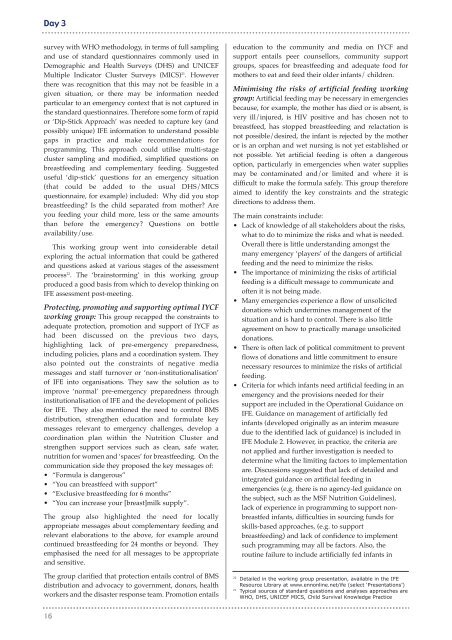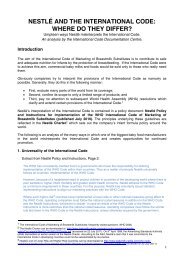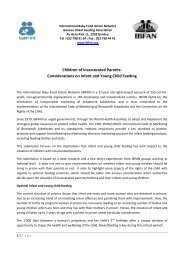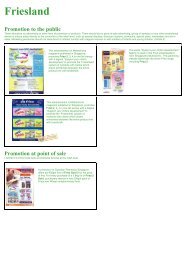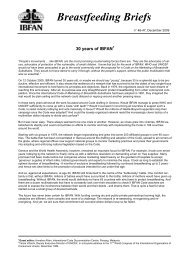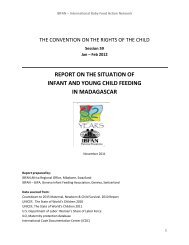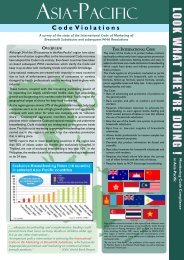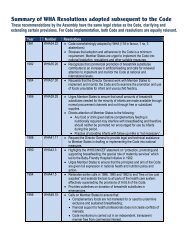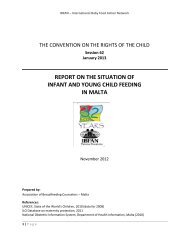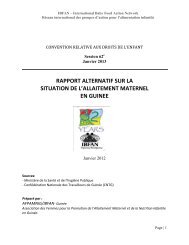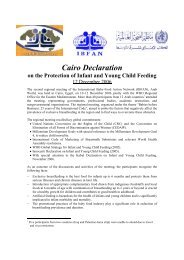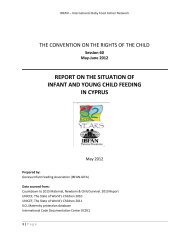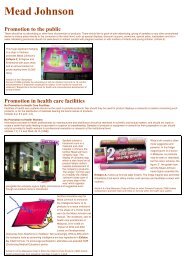Infant and young child feeding in emergencies. Making it ... - IBFAN
Infant and young child feeding in emergencies. Making it ... - IBFAN
Infant and young child feeding in emergencies. Making it ... - IBFAN
Create successful ePaper yourself
Turn your PDF publications into a flip-book with our unique Google optimized e-Paper software.
Day 3<br />
survey w<strong>it</strong>h WHO methodology, <strong>in</strong> terms of full sampl<strong>in</strong>g<br />
<strong>and</strong> use of st<strong>and</strong>ard questionnaires commonly used <strong>in</strong><br />
Demographic <strong>and</strong> Health Surveys (DHS) <strong>and</strong> UNICEF<br />
Multiple Indicator Cluster Surveys (MICS) 21 . However<br />
there was recogn<strong>it</strong>ion that this may not be feasible <strong>in</strong> a<br />
given s<strong>it</strong>uation, or there may be <strong>in</strong>formation needed<br />
particular to an emergency context that is not captured <strong>in</strong><br />
the st<strong>and</strong>ard questionnaires. Therefore some form of rapid<br />
or ‘Dip-Stick Approach’ was needed to capture key (<strong>and</strong><br />
possibly unique) IFE <strong>in</strong>formation to underst<strong>and</strong> possible<br />
gaps <strong>in</strong> practice <strong>and</strong> make recommendations for<br />
programm<strong>in</strong>g. This approach could utilise multi-stage<br />
cluster sampl<strong>in</strong>g <strong>and</strong> modified, simplified questions on<br />
breast<strong>feed<strong>in</strong>g</strong> <strong>and</strong> complementary <strong>feed<strong>in</strong>g</strong>. Suggested<br />
useful ‘dip-stick’ questions for an emergency s<strong>it</strong>uation<br />
(that could be added to the usual DHS/MICS<br />
questionnaire, for example) <strong>in</strong>cluded: Why did you stop<br />
breast<strong>feed<strong>in</strong>g</strong>? Is the <strong>child</strong> separated from mother? Are<br />
you <strong>feed<strong>in</strong>g</strong> your <strong>child</strong> more, less or the same amounts<br />
than before the emergency? Questions on bottle<br />
availabil<strong>it</strong>y/use.<br />
This work<strong>in</strong>g group went <strong>in</strong>to considerable detail<br />
explor<strong>in</strong>g the actual <strong>in</strong>formation that could be gathered<br />
<strong>and</strong> questions asked at various stages of the assessment<br />
process 22 . The ‘bra<strong>in</strong>storm<strong>in</strong>g’ <strong>in</strong> this work<strong>in</strong>g group<br />
produced a good basis from which to develop th<strong>in</strong>k<strong>in</strong>g on<br />
IFE assessment post-meet<strong>in</strong>g.<br />
Protect<strong>in</strong>g, promot<strong>in</strong>g <strong>and</strong> support<strong>in</strong>g optimal IYCF<br />
work<strong>in</strong>g group: This group recapped the constra<strong>in</strong>ts to<br />
adequate protection, promotion <strong>and</strong> support of IYCF as<br />
had been discussed on the previous two days,<br />
highlight<strong>in</strong>g lack of pre-emergency preparedness,<br />
<strong>in</strong>clud<strong>in</strong>g policies, plans <strong>and</strong> a coord<strong>in</strong>ation system. They<br />
also po<strong>in</strong>ted out the constra<strong>in</strong>ts of negative media<br />
messages <strong>and</strong> staff turnover or ‘non-<strong>in</strong>st<strong>it</strong>utionalisation’<br />
of IFE <strong>in</strong>to organisations. They saw the solution as to<br />
improve ‘normal’ pre-emergency preparedness through<br />
<strong>in</strong>st<strong>it</strong>utionalisation of IFE <strong>and</strong> the development of policies<br />
for IFE. They also mentioned the need to control BMS<br />
distribution, strengthen education <strong>and</strong> formulate key<br />
messages relevant to emergency challenges, develop a<br />
coord<strong>in</strong>ation plan w<strong>it</strong>h<strong>in</strong> the Nutr<strong>it</strong>ion Cluster <strong>and</strong><br />
strengthen support services such as clean, safe water,<br />
nutr<strong>it</strong>ion for women <strong>and</strong> ‘spaces’ for breast<strong>feed<strong>in</strong>g</strong>. On the<br />
communication side they proposed the key messages of:<br />
• “Formula is dangerous”<br />
• “You can breastfeed w<strong>it</strong>h support”<br />
• “Exclusive breast<strong>feed<strong>in</strong>g</strong> for 6 months”<br />
• “You can <strong>in</strong>crease your [breast]milk supply”.<br />
The group also highlighted the need for locally<br />
appropriate messages about complementary <strong>feed<strong>in</strong>g</strong> <strong>and</strong><br />
relevant elaborations to the above, for example around<br />
cont<strong>in</strong>ued breast<strong>feed<strong>in</strong>g</strong> for 24 months or beyond. They<br />
emphasised the need for all messages to be appropriate<br />
<strong>and</strong> sens<strong>it</strong>ive.<br />
The group clarified that protection entails control of BMS<br />
distribution <strong>and</strong> advocacy to government, donors, health<br />
workers <strong>and</strong> the disaster response team. Promotion entails<br />
education to the commun<strong>it</strong>y <strong>and</strong> media on IYCF <strong>and</strong><br />
support entails peer counsellors, commun<strong>it</strong>y support<br />
groups, spaces for breast<strong>feed<strong>in</strong>g</strong> <strong>and</strong> adequate food for<br />
mothers to eat <strong>and</strong> feed their older <strong>in</strong>fants/ <strong>child</strong>ren.<br />
M<strong>in</strong>imis<strong>in</strong>g the risks of artificial <strong>feed<strong>in</strong>g</strong> work<strong>in</strong>g<br />
group: Artificial <strong>feed<strong>in</strong>g</strong> may be necessary <strong>in</strong> <strong>emergencies</strong><br />
because, for example, the mother has died or is absent, is<br />
very ill/<strong>in</strong>jured, is HIV pos<strong>it</strong>ive <strong>and</strong> has chosen not to<br />
breastfeed, has stopped breast<strong>feed<strong>in</strong>g</strong> <strong>and</strong> relactation is<br />
not possible/desired, the <strong>in</strong>fant is rejected by the mother<br />
or is an orphan <strong>and</strong> wet nurs<strong>in</strong>g is not yet established or<br />
not possible. Yet artificial <strong>feed<strong>in</strong>g</strong> is often a dangerous<br />
option, particularly <strong>in</strong> <strong>emergencies</strong> when water supplies<br />
may be contam<strong>in</strong>ated <strong>and</strong>/or lim<strong>it</strong>ed <strong>and</strong> where <strong>it</strong> is<br />
difficult to make the formula safely. This group therefore<br />
aimed to identify the key constra<strong>in</strong>ts <strong>and</strong> the strategic<br />
directions to address them.<br />
The ma<strong>in</strong> constra<strong>in</strong>ts <strong>in</strong>clude:<br />
• Lack of knowledge of all stakeholders about the risks,<br />
what to do to m<strong>in</strong>imize the risks <strong>and</strong> what is needed.<br />
Overall there is l<strong>it</strong>tle underst<strong>and</strong><strong>in</strong>g amongst the<br />
many emergency ‘players’ of the dangers of artificial<br />
<strong>feed<strong>in</strong>g</strong> <strong>and</strong> the need to m<strong>in</strong>imize the risks.<br />
• The importance of m<strong>in</strong>imiz<strong>in</strong>g the risks of artificial<br />
<strong>feed<strong>in</strong>g</strong> is a difficult message to communicate <strong>and</strong><br />
often <strong>it</strong> is not be<strong>in</strong>g made.<br />
• Many <strong>emergencies</strong> experience a flow of unsolic<strong>it</strong>ed<br />
donations which underm<strong>in</strong>es management of the<br />
s<strong>it</strong>uation <strong>and</strong> is hard to control. There is also l<strong>it</strong>tle<br />
agreement on how to practically manage unsolic<strong>it</strong>ed<br />
donations.<br />
• There is often lack of pol<strong>it</strong>ical comm<strong>it</strong>ment to prevent<br />
flows of donations <strong>and</strong> l<strong>it</strong>tle comm<strong>it</strong>ment to ensure<br />
necessary resources to m<strong>in</strong>imize the risks of artificial<br />
<strong>feed<strong>in</strong>g</strong>.<br />
• Cr<strong>it</strong>eria for which <strong>in</strong>fants need artificial <strong>feed<strong>in</strong>g</strong> <strong>in</strong> an<br />
emergency <strong>and</strong> the provisions needed for their<br />
support are <strong>in</strong>cluded <strong>in</strong> the Operational Guidance on<br />
IFE. Guidance on management of artificially fed<br />
<strong>in</strong>fants (developed orig<strong>in</strong>ally as an <strong>in</strong>terim measure<br />
due to the identified lack of guidance) is <strong>in</strong>cluded <strong>in</strong><br />
IFE Module 2. However, <strong>in</strong> practice, the cr<strong>it</strong>eria are<br />
not applied <strong>and</strong> further <strong>in</strong>vestigation is needed to<br />
determ<strong>in</strong>e what the lim<strong>it</strong><strong>in</strong>g factors to implementation<br />
are. Discussions suggested that lack of detailed <strong>and</strong><br />
<strong>in</strong>tegrated guidance on artificial <strong>feed<strong>in</strong>g</strong> <strong>in</strong><br />
<strong>emergencies</strong> (e.g. there is no agency-led guidance on<br />
the subject, such as the MSF Nutr<strong>it</strong>ion Guidel<strong>in</strong>es),<br />
lack of experience <strong>in</strong> programm<strong>in</strong>g to support nonbreastfed<br />
<strong>in</strong>fants, difficulties <strong>in</strong> sourc<strong>in</strong>g funds for<br />
skills-based approaches, (e.g. to support<br />
breast<strong>feed<strong>in</strong>g</strong>) <strong>and</strong> lack of confidence to implement<br />
such programm<strong>in</strong>g may all be factors. Also, the<br />
rout<strong>in</strong>e failure to <strong>in</strong>clude artificially fed <strong>in</strong>fants <strong>in</strong><br />
22<br />
Detailed <strong>in</strong> the work<strong>in</strong>g group presentation, available <strong>in</strong> the IFE<br />
Resource Library at www.ennonl<strong>in</strong>e.net/ife (select ‘Presentations’)<br />
21<br />
Typical sources of st<strong>and</strong>ard questions <strong>and</strong> analyses approaches are<br />
WHO, DHS, UNICEF MICS, Child Survival Knowledge Practice<br />
16


